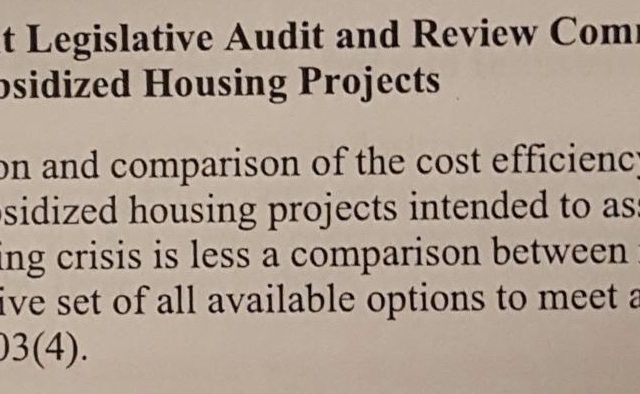The Dori Monson Show Highlights Non-Proift Housing Industrial Complex
Once again Dori Monson gets it and then says something about it. And, as I wrote last week here and at Forbes, Governor Jay Inslee simply doesn’t get how housing works; or he does and he doesn’t want anyone to know about it. Every time I point out and criticize spendy subsidized projects, I get defenders of the system that produces them that say, “That’s not a fair comparison,” or “That isn’t the way to calculate unit costs (take project cost and divide by the number of units).” OK, I’m doing it wrong. Then how should we calculate unit cost if it isn’t taking the $92 million spent on 200 units and dividing and getting almost $500,000 per unit? Then there’s just crickets. One person offered a scheme by which all the money from non-housing sources would be subtracted then somehow the retail would be taken out, producing the laughable per unit price of $97,000. Right.
The fact is we simply don’t know how housing units compare across industries, across neighborhoods, cities, urban, suburban, and rural. There are many different nuances in how projects end up coming together. Wouldn’t it make sense to dig into those with some experts and get a really accurate accounting of costs? Then we could all work together to reduce those costs. Some of the things pushing up housing costs and slowing production might be regulatory, some might be related to labor, others might differ from place to place and time to time. We need to know if we’re going to figure out how to lower housing prices. We do know that just adding taxes, fees, and more process with Mandatory Inclusionary Zoning is not the answer. Let’s find out what the answer is to lower costs, increase production and thus, lower prices.
Here’s the segment.
Happy 4th of July: Taxes, Revolution, and Housing
I always try to write something for the July 4th holiday, whether it is on Facebook or here or somewhere else. The holiday for me has always aroused mixed feelings. There’s the crowds and the heat, but also the food and, sometimes, connecting with people in backyards or some public place or somewhere with an exceptional view to watch fireworks. It’s also all about America’s Birthday, the anniversary of the signing of the Declaration of Independence. And the revolution was, ostensibly, about “taxation with out representation,” a notion that can be challenged but is still bedrock in our national consciousness (this is actually a fundamental misunderstanding of the American Revolution and you can read more about that in a different post).
While people have called me a libertarian as an insult, I’m not. I don’t see taxation as necessarily theft, although it can be in some circumstances. I have a pretty simple view of taxation. Taxes are important and useful for three reasons.
First, taxes are a way of gathering money to pay for things that the market would struggle to produce. For example, think about a park. Land can be worth a lot in a growing city, and taxes can be raised to purchase land and set it aside for free open space. While someone could do this as a money making venture, they probably wouldn’t. Housing or commercial space would be far more lucrative, so taxes are a good way to pay for this kind of community benefit that otherwise might happen.
Second, taxes also influence behavior by raising or lowering prices. As a Hayekian liberal, I see prices as the most important signal in the market place. When prices go up or down, various behaviors ensue. Taxes or subsidies (a negative tax) either encourage or discourage behavior. Increasing taxes on things like gasoline, cigarettes, or water would likely result in people trying to use less of those things, either through conservation, finding substitutes or giving up using them all together. Making those things cheaper would have the reverse effect.
Lastly, taxes move money around the economy by redistributing wealth. I acknowledge this not as a normative or prescriptive motivation; it’s just a fact. When taxes or subsidies are used, money moves out of some people’s pockets into others. Whether that transfer is fair, equitable, or otherwise depends on many factors, but it is what taxation always does. Policy makers must always recognize that there is no perfectly fair tax and must always be considering who is benefiting, who’s losing, and why and adjust accordingly.
Seattle is faced with the greatest crisis it has faced since it was first founded out at the edge of the wild frontier. We are a place in the world with tremendous growth and opportunity, growth that means more jobs, and more people. Those new people need housing, and our production is not keeping up, so prices are rising. Pressure is building to tax housing production in the name of lowering its price. This is folly.
But this move is rooted in a reading of economics and politics that would claim that building more housing, encouraging more economic growth, and welcoming new people into our community is coming at the expense of something called “social justice.” The notion is that poor people, people of color and especially black people, are being oppressed by this growth.
However, this view benefits existing property owners who, having already invested in property, now benefit from the scarcity of housing; they have a scare thing that is in high demand. Meanwhile the people that are supposedly being oppressed are certain to suffer more with higher prices.
The solution of adding costs through taxation of new housing product which would actually meet demand and have a salutary impact on prices isn’t a solution at all, but an insurance policy for those who already own a place to live.
Going back to my basic formulation of taxation, we are now on the verge of discouraging the production of housing and redistributing wealth from poor renters to wealthy homeowners. As per square foot fees add to rents and limit production, prices for single-family homes will certainly go up; it’s almost as if every dollar coming out of the pocket of a renter in the Central District, Capitol Hill, and Ballard, will now be vacuumed up into the equity of homeowners in Laurelhurst, Magnolia, and Arbor Heights. How is this social justice?
Instead of filling the streets in protest against the taxes imposed on new housing that will make their lives worse, renters are being encouraged to call for more taxation than is already proposed by the City in it’s Mandatory Inclusionary Zoning (MIZ) scheme. The supposedly revolutionary, socialist element is demanding more taxation of a good thing, housing, to stop inequality.
Instead of a revolution, this movement is reactionary, seeking to take the city backward, to a time of no or slow growth. Yet almost every candidate running for City office says this is a plan they’ll keep going with it. What’s happening to our city is that the banner of “social justice” has been transformed into a set of taxes that will siphon money from the poor into the hands of wealthy property owners.
If our city to step away from the brink of this disaster, City government must stop MIZ in it’s tracks immediately and reassess how we can develop an approach to housing that dramatically increases the production of market rate housing so that it meets or exceeds demand, then efficiently distributes subsidies to people still struggling with costs of living (not just housing). The taxes we collect from the levy can buy the public benefit that the market can’t produce.
By doing this, we would create a public benefit that the market can’t produce (low priced housing and guaranteed income for people struggling), incentives for the market to produce more of a good thing (housing), and take wealth from existing homeowners and give it to poorer people who rent (use the levy to redistribute wealth). This is a plan that isn’t revolutionary but just makes common sense, something that, along with housing, is in short supply in Seattle.
Governor Inslee Fails Simple Test and Vetos a Study on Housing Costs
Over the last year two years, non-profit housing agencies, the Capitol Hill Housing Improvement Program (CHIP) and El Centro De La Raza (El Centro), each completed a housing projects, CHIP on Capitol Hill in 2015 and El Centro on Beacon Hill last year, in 2016. The CHIP project has 88 units of housing and the El Centro project 112, a total of 200 units. The total cost of the CHIP project was $47 million, $534, 091 per unit, and the El Centro project $45 million, or $401,786 per unit. Together, the two projects cost $92 million for 200 units of subsidized, rent restricted housing, $460,000 per unit. The El Centro project has a wait list that is five years long.
Meanwhile, in Eastern Washington the Growers League produced 200 units of shelter beds for farmworkers for $3 million or about $150,000 per unit. And every developer I’ve talked with tells me that not only is the cost of these projects exceedingly high (there are many townhomes in Seattle in the $400,000 to $600,000 range), but market rate builders and developers build multifamily housing for anywhere from $150,000 to $200,000 per unit, about half what the two agencies spent to build their projects.
Why is there such a big difference?
Well, the Governor of Washington, Jay Inslee, isn’t interested in asking or answering that question.
Last week, the Governor vetoed a budget item that would have set aside $500,000 to fund a study by the Joint Legislative Audit and Review Committee (JLARC) to do just that. His veto message said, in part,
The solution to our state’s housing crisis is less a comparison between market rate and subsidized housing than it is a comprehensive set of all available options to meet a serious need. For this reason, I have vetoed Section 103(4).
Aside from the awkward phrasing, the statement raises more questions than it answers about the Governor’s view of housing in the state. When did the “housing crisis” start? What is the crisis? If the crisis is a rise in housing prices, why are those prices rising? How can we find a solution if we don’t know why? And if subsidized housing is part of the, “set of all available options,” shouldn’t we understand how we could improve the efficiency of those subsidies?
Not according to Inslee. From his statement, it’s pretty clear that “all available options” means more money for the non-profit housing industrial complex: don’t ask questions just find more money.
What the Governor and his housing advisor Jim Baumgart have done is to essentially communicate that his letter sent to the Affordable Housing Advisory Board (AHAB) wasn’t serious. In that letter, delivered with a strong message by Baumgart that the Governor wouldn’t settle for just another long, wordy report, the Governor called for looking at “zoning and planning, permitting, development, and financing and construction processes” and that the AHAB should, “define where barriers exist and provide recommendation on how to remove these barriers.”
The product of that letter was a lengthy, and wordy report that had very little in terms of actual analysis of the causes of high prices and rehashed a lot of older, unimplemented recommendations that would have little impact on the production of housing.
Baumgart and Inslee are smart people. Even if all the letter was intended to do was find out how to produce more non-profit subsidized housing, the most obvious question would be, “are we paying more for units than we should, and is there a way to make our subsidies go further, to create more non-profit subsidized units?” This leaves aside the basic and fundamental economic fact that housing is expensive because there are more people that need housing that the market and the non-profits can produce. Why would Inslee and his advisor say that this isn’t important? The answer is simple: politics.
The non-profit housing industrial housing complex has a lot of power and pull, and they don’t want the public or people making policy to find out that their product is so costly to produce.
Unfortunately while Inslee and Baumgart cave to the non-profit’s powerful lobby that doesn’t want a light on their inefficient and corrupt system, there is a young person struggling to find a place to live, there is a family making a tough choice about living far away from work because housing in Seattle is too expensive, and a man who doesn’t have enough money to move away from his partner that is becoming more and more violent. This is the real world. The Governor would rather not know why these people have to wait five years for those $500,000 housing units. I wonder if it’s because of the costs to produce those units. Thanks to his veto and the non-profit industry, we won’t know the answer.
666: The Devil’s Post
Well, here we are. This is the 666th post on the Smart Growth Seattle website. Maybe this is the end. We’ll see what happens next. Over the course of the last four years we’ve been joined by a variety of contributors and covered a range of topics and issues. I wish I could look back at all these posts and say they had made a big difference. I can’t. But that is the nature of both promoting change for a better future and protecting what is valuable about our past. My experience with the smoking ban is a lesson I try to keep in mind. There wasn’t one thing that made the difference in moving our state and city toward a wide and comprehensive limit on smoking. But there were moments to remember.
One of those moments came after we passed the smoking ban and I got a call from a major contractor working on big high rise projects downtown.
“Can we ban smoking on our work sites with this new law?” the voice asked.
“Of course,” I said. “Just do it.”
“That’s all I needed to know,” the voice said. “Thank you.”
And just like that, smoking was banned at numerous worksites. I’d guess that there isn’t a major worksite that allows smoking.
The truth is the law had nothing to do with that specific issue. The employer, in this case, didn’t need the law. They could have banned smoking because they wanted to. All I did was give them permission. The nervous and worried people at the Department of Health at the state level had given them a long bureaucratic answer. Maybe. Maybe not. Blah. Blah. Blah.
“Just do it!”
I was just in Louisiana on a brief trip and we managed to fit in a boat trip out to the bayous and swamps outside New Orleans. The tour guide boated us all over and alligators would come up to the boat and he, and anyone else who wanted, could take a stick with a hot dog and feed the alligators.
“The big ones are awfully shy,” the tour guide told us. “They didn’t get that big by taking lots of risks.”
So it is with people and bureaucracies. The alligator repeated himself a lot, and he said more than once when talking about the alligators, “That’s two hundred million years of evolution right there!”
There are two things about evolution that are important. One is that it tends to favor stability. Stay out of trouble, avoid conflict and you’ll live to be a big and old gator in the swamp. The second, is that change is inevitable, and when the environment changes the organisms that can adapt to change end up passing on their genes into the future.
What’s true of the swamp is true of social change. Yes, if we go with the flow on housing issues and just accept bad policy like Mandatory Inclusionary Zoning (MIZ) some of us might be ok and get fatter, longer, and older. But, if we hang on, we might just find that things will change. And if we’re patient, people will come around.
When was the last time you heard someone complain about cigarette smoke in a bar in Seattle? When was the last time you heard someone complain about a no smoking policy in an apartment building? In a rental property? In a rental car?
So here’s to the next 666 blog posts. Maybe I won’t have to write that many more before we get where we need to be.
Alligators. The Omen. Cigarette smoke. Bad housing policies. I hope I didn’t give you nightmares.
The Mayor and City: Bad Policy Backed by Bad Data.
There is a pretty damning report by Daniel Person at the Seattle Weekly that found the City, and in particular the Mayor, cooked the books on the impacts of the $15 minimum wage
To review, the timeline seems to have gone like this: The UW shares with City Hall an early draft of its study showing the minimum wage law is hurting the workers it was meant to help; the mayor’s office shares the study with researchers known to be sympathetic toward minimum wage laws, asking for feedback; those researchers release a report that’s high on Seattle’s minimum wage law just a week before the negative report comes out.
I wish I could be shocked, but it isn’t surprising. Remember when Tom Rasmussen and Sally Bagshaw wrote to the Mayor saying that we needed to build 6,000 units of subsidized housing for a decade to solve the “housing crisis.” They said,
To reach 60,000 – 85,000 units, we must increase our supply by over 6,000-8,500 units of affordable housing annually for the next ten years if we are to make room for the people who want to live and work in our community. If we want to extend that period to twenty years, we need 3,000-4000+ units annually to reach our goal. This will require new approaches.
If it wasn’t for some quick analysis of the City’s shoddy work, those crazy numbers (the entire housing economy produced around 4,000 units; that’s the entire production!) might have stuck. The City tipped the scale by not counting existing subsidized units and voucher programs.
The City has betrayed common sense and is now just manufacturing data to prop up bad policy. It’s a pretty disgusting mess at City Hall. I’m not sure how these people sleep at night.
You can read Person’s whole story for more, but the truth isn’t the only victim. The City’s bad policies and bad data are propping up the runaway train of Mandatory Inclusionary Zoning (MIZ) and the real victims are people who will see their housing costs going up and up while the City makes things up to explain why builders are to blame. Just another day at the office for bureaucrats at the City.






